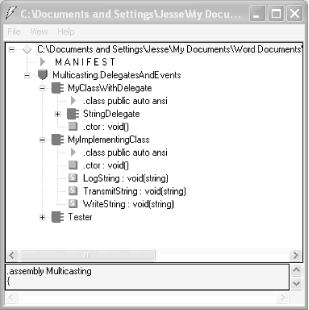Manifests
As part of its metadata, every assembly has a manifest. This describes what is in the assembly, including identification information (name, version, etc.), a list of the types and resources in the assembly, a map to connect public types with the implementing code, and a list of assemblies referenced by this assembly.
Even the simplest program has a manifest. You can examine that manifest using ILDasm, which is provided as part of your development environment. When you open it in ILDasm, the EXE program created by Example 12-3 looks like Figure 17-1.

Figure 17-1. ILDasm of Example 12-3
Notice the manifest (second line from the top). Double-clicking the manifest opens a Manifest window, as shown in Figure 17-2.

Figure 17-2. The manifest window
This file serves as a map of the contents of the assembly. You can see in the first line the reference to the mscorlib assembly, which is referenced by this and every .NET application. The mscorlib assembly is the core library assembly for .NET and is available on every .NET platform.
The manifest references a number of libraries used in the program such as Microsoft.VisualBasic, System, System.Data, and System.XML. Finally, towards the bottom of the image, you see a a reference to the assembly from Example 12-3. You can also see ...
Get Programming Visual Basic .NET, Second Edition now with the O’Reilly learning platform.
O’Reilly members experience books, live events, courses curated by job role, and more from O’Reilly and nearly 200 top publishers.

